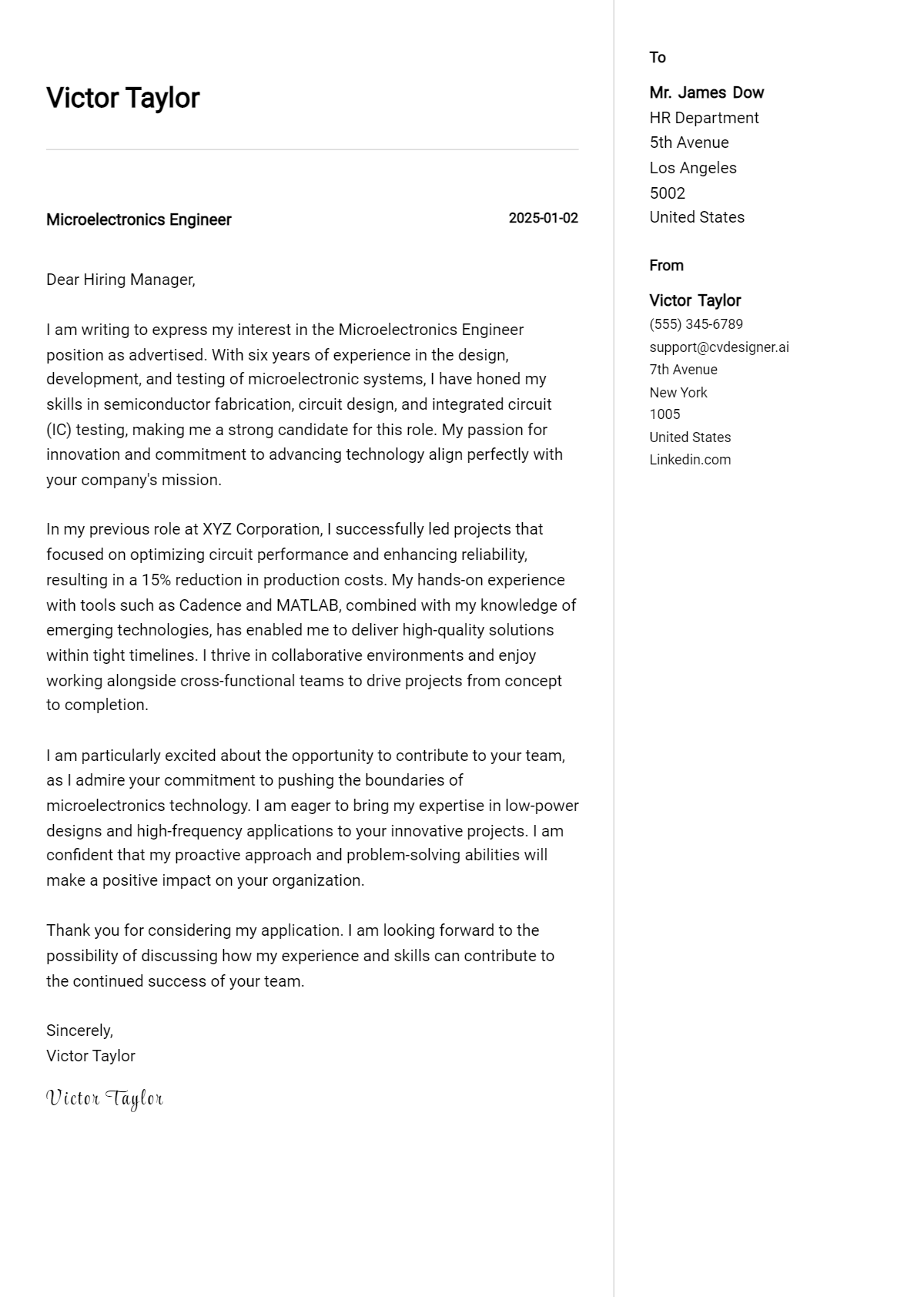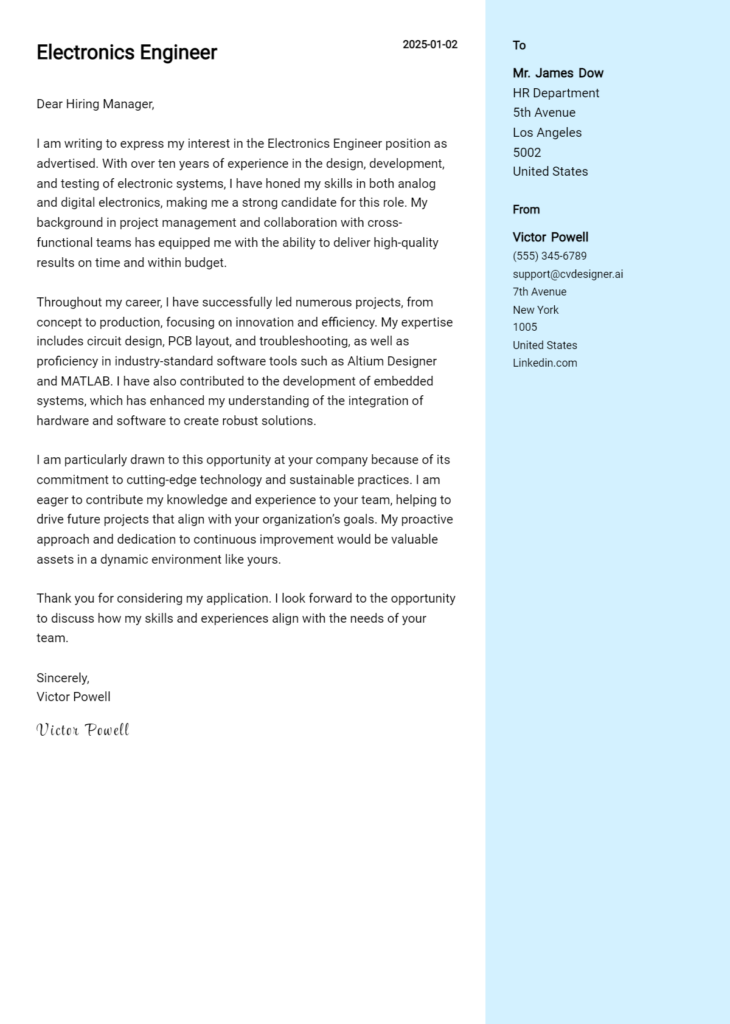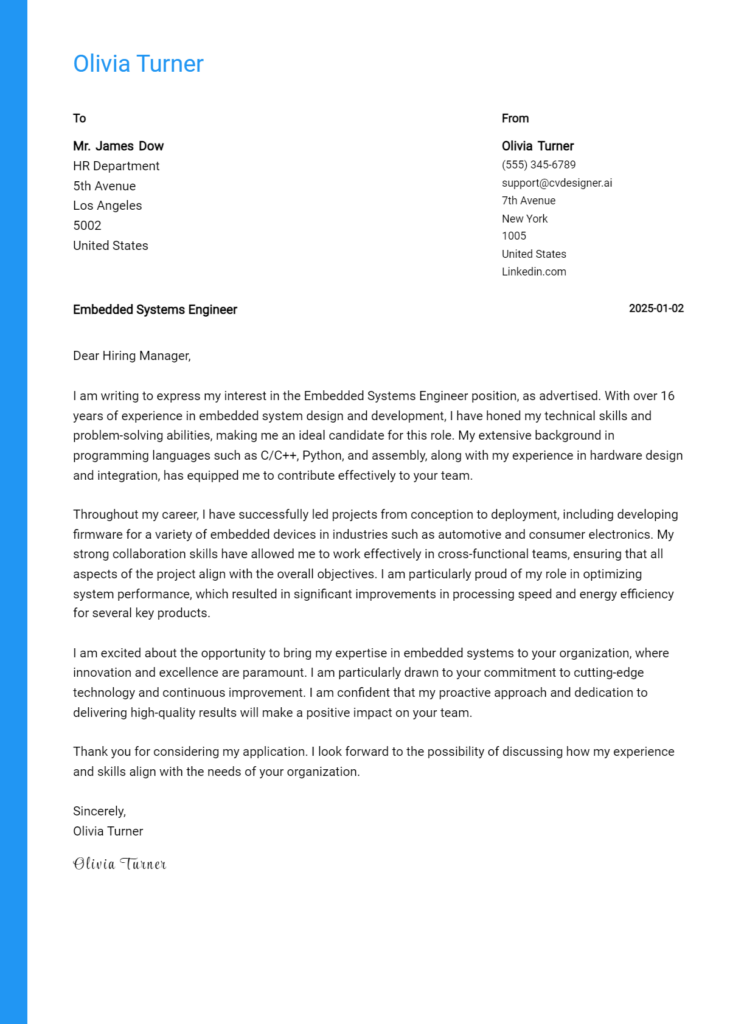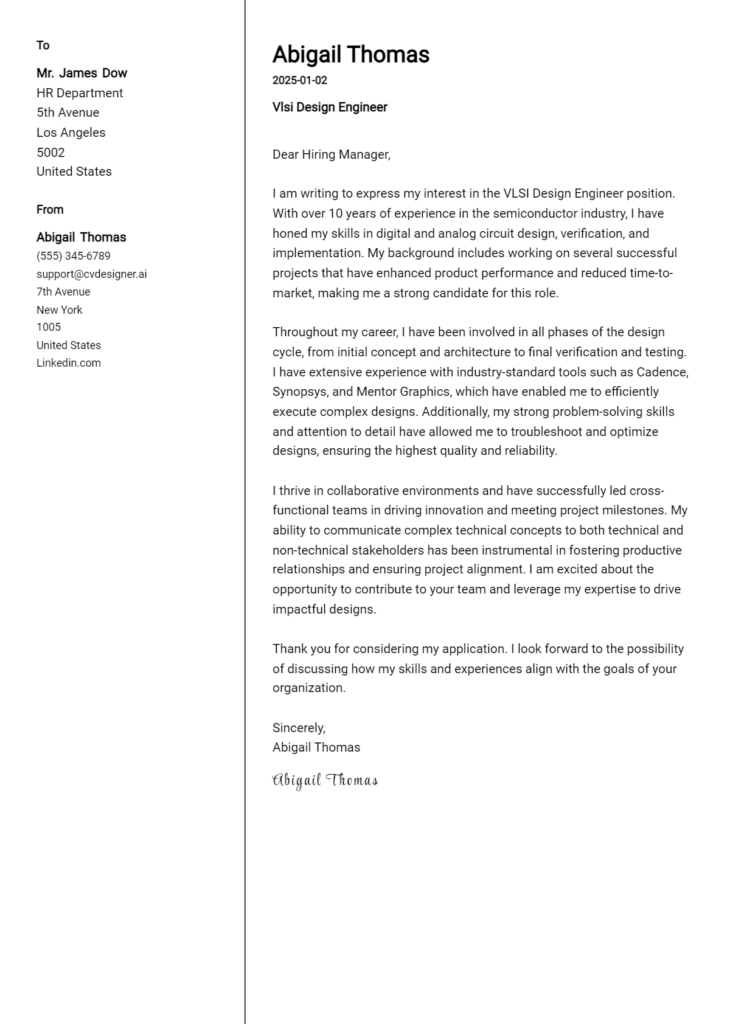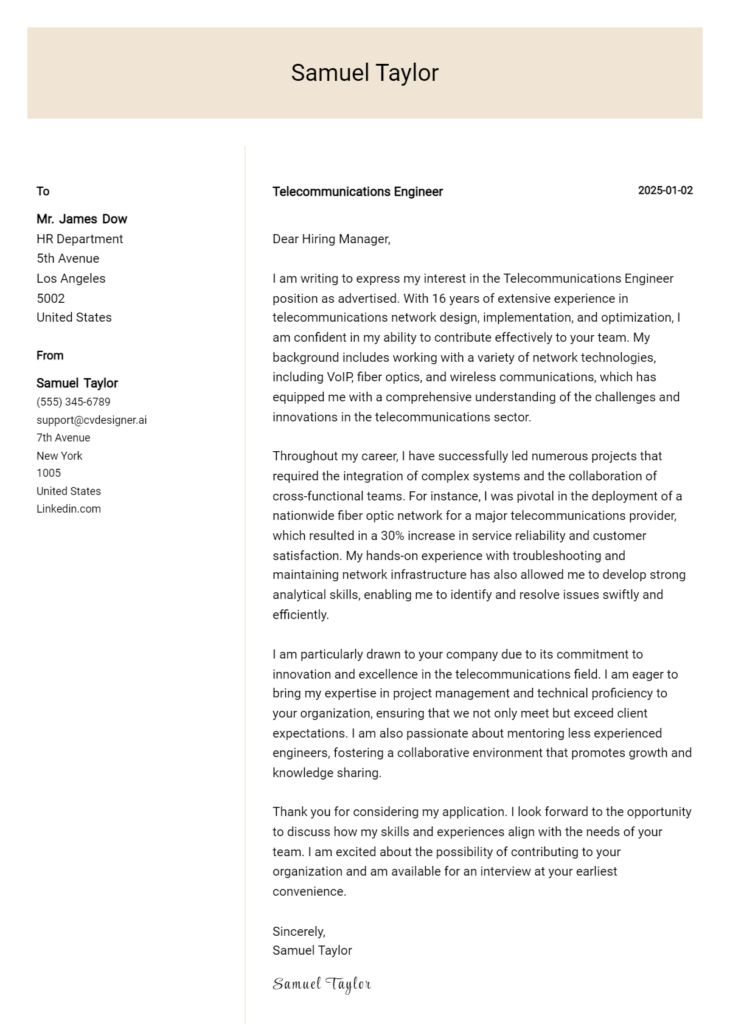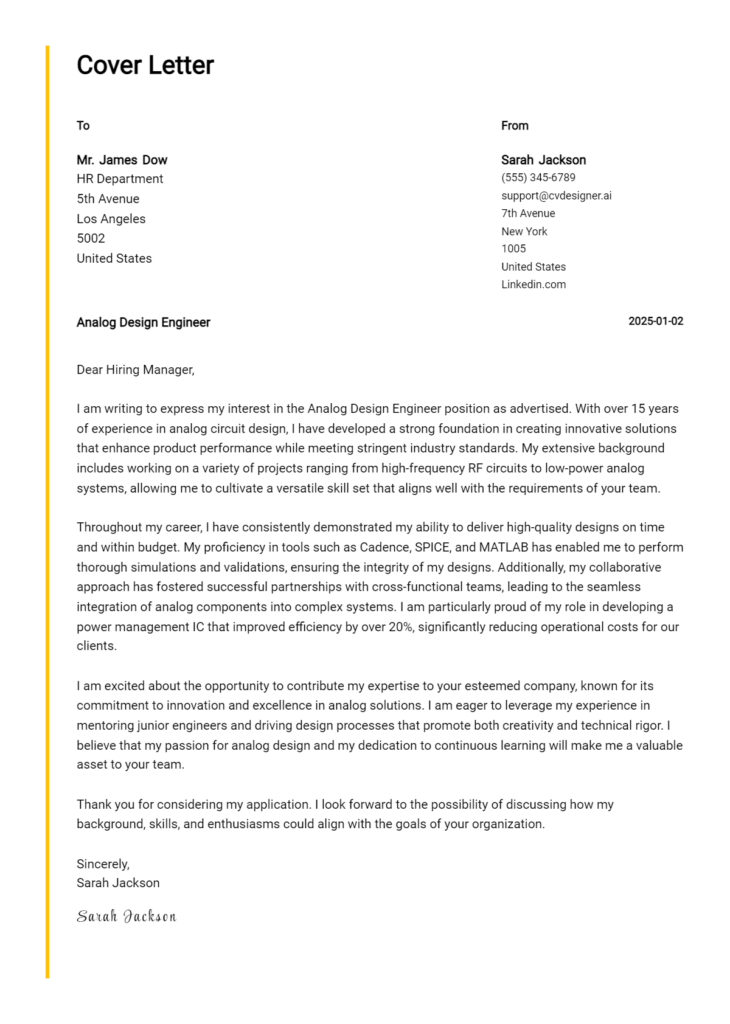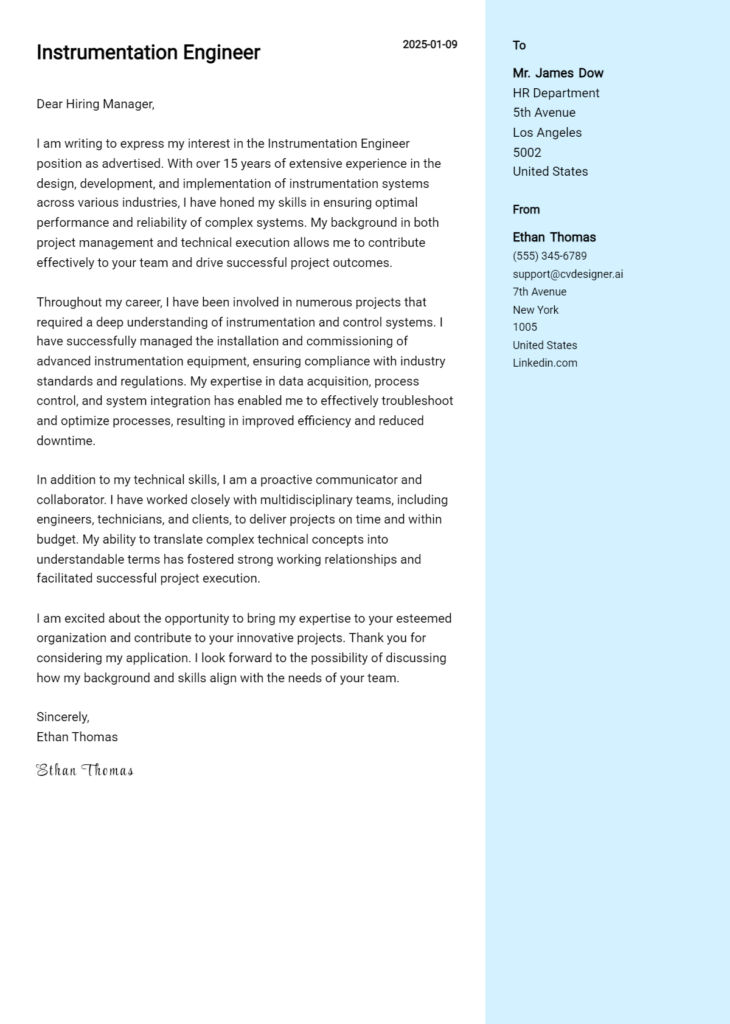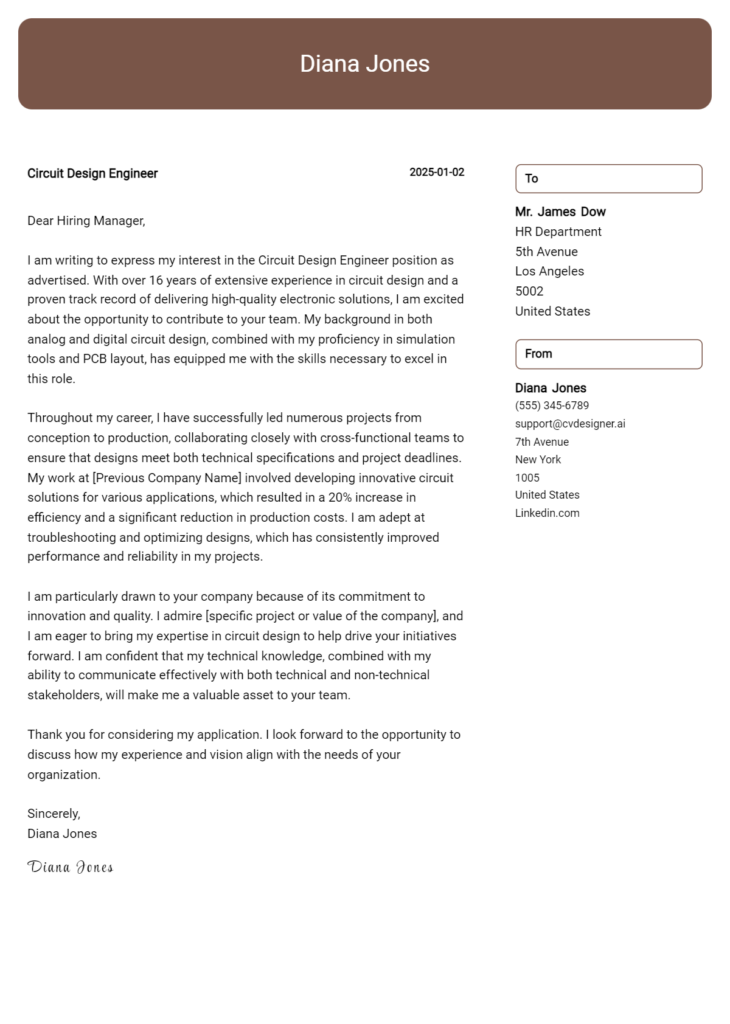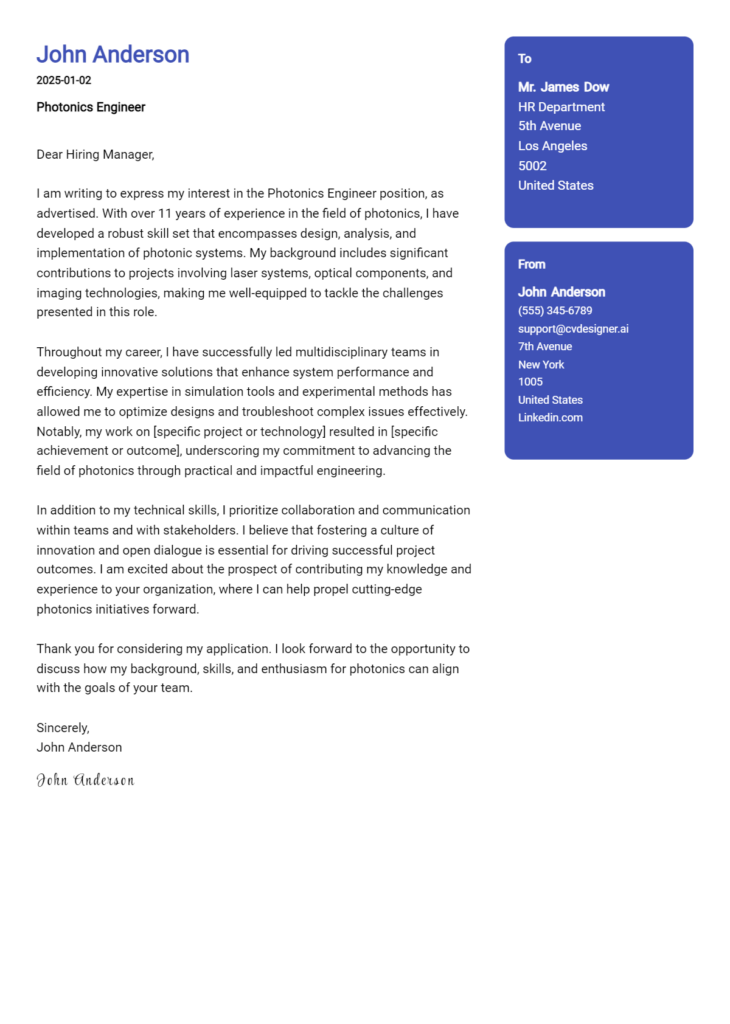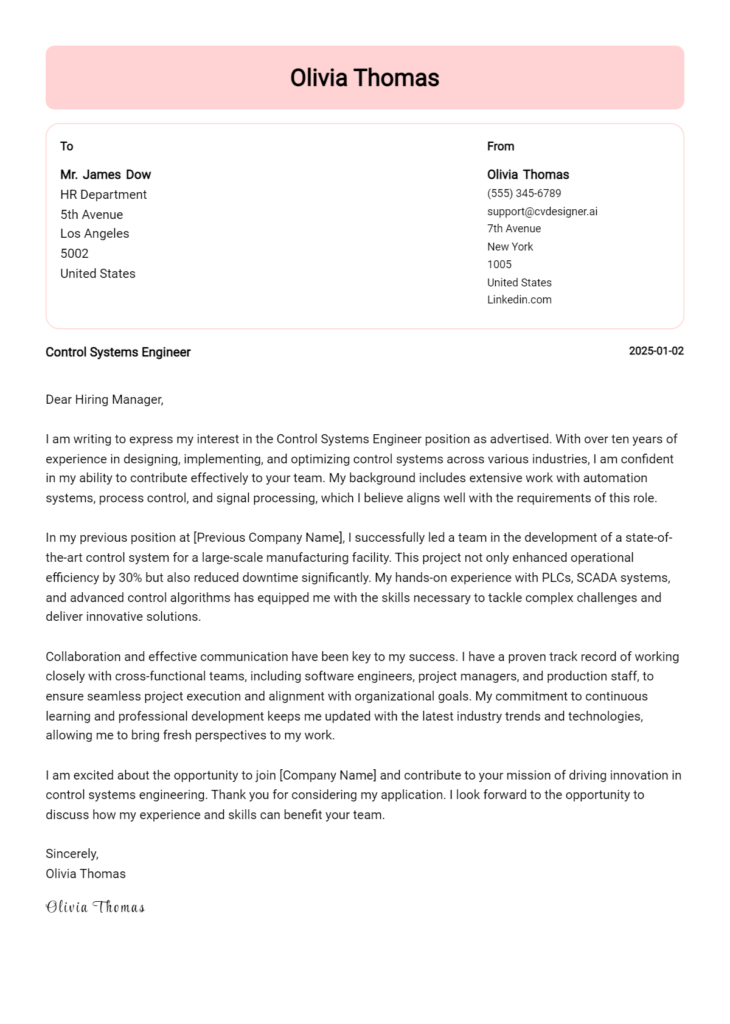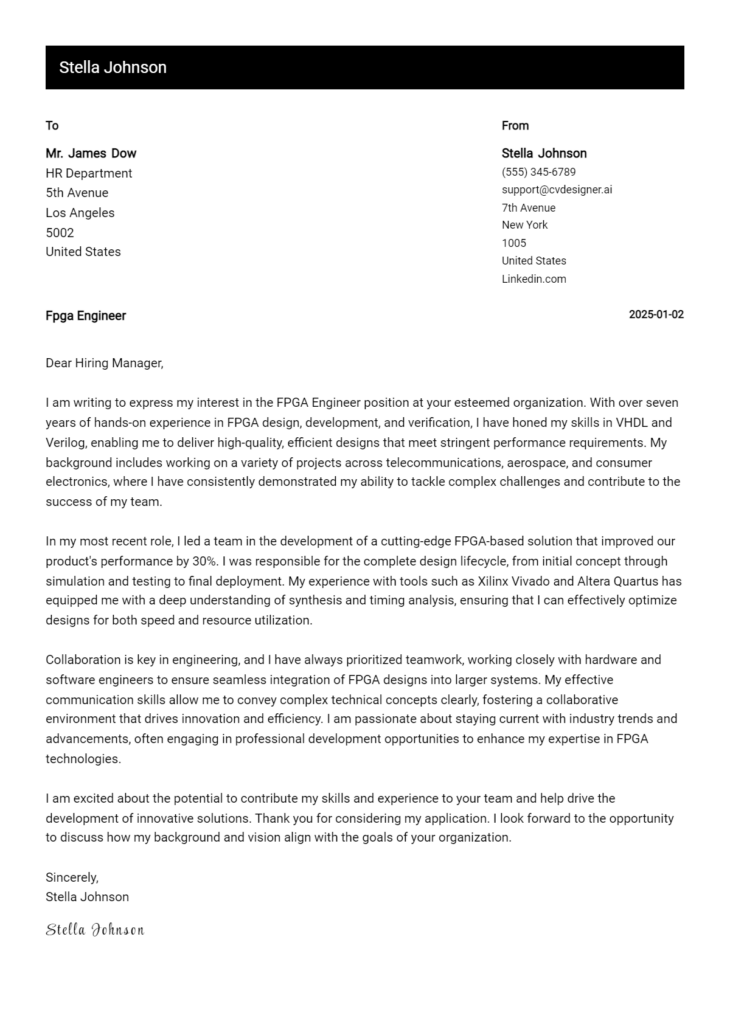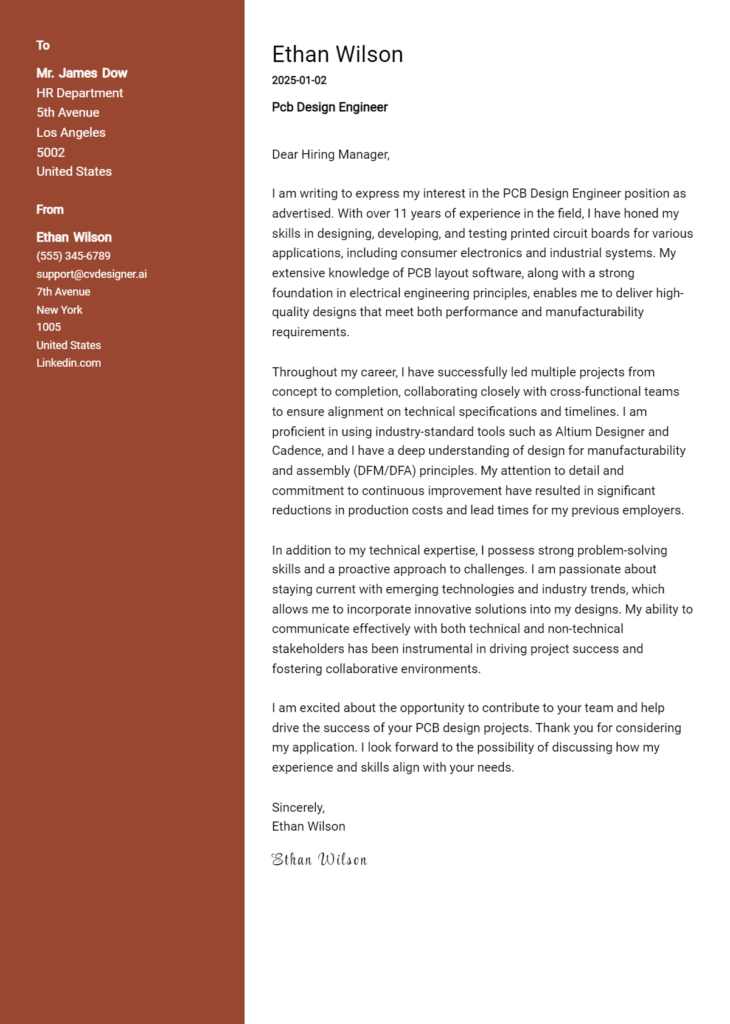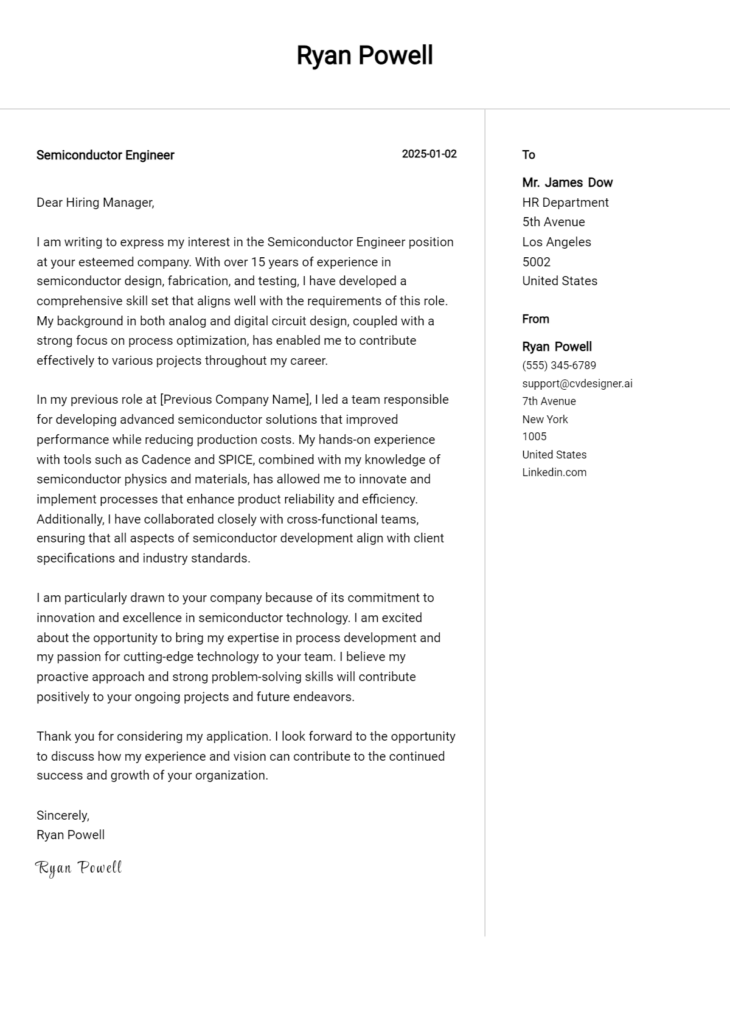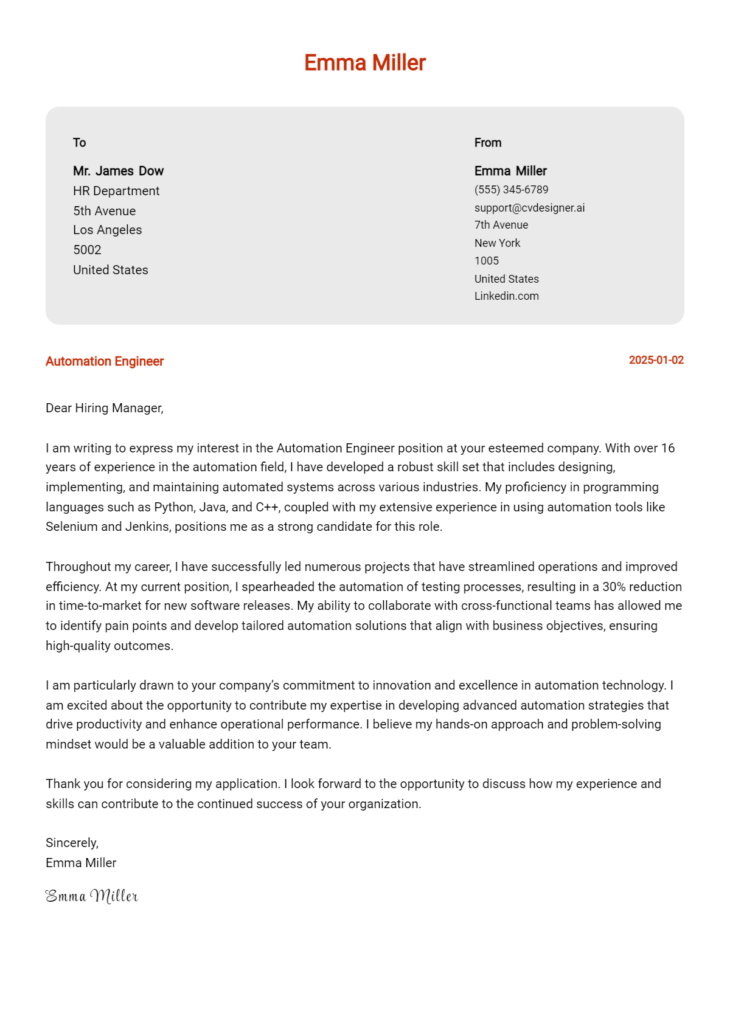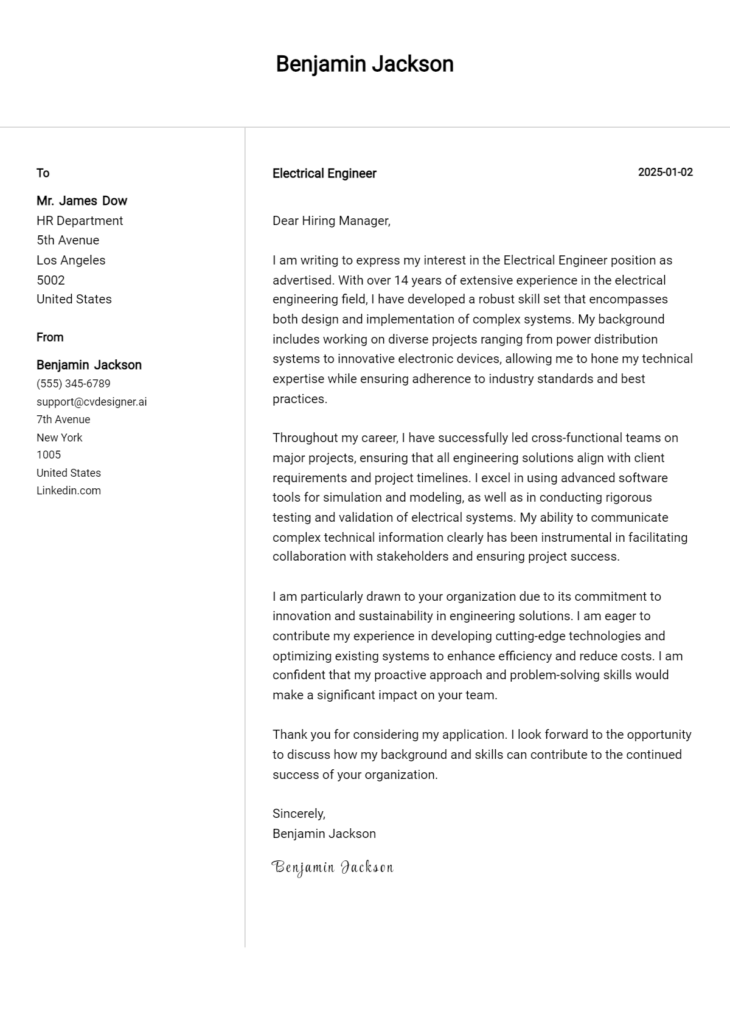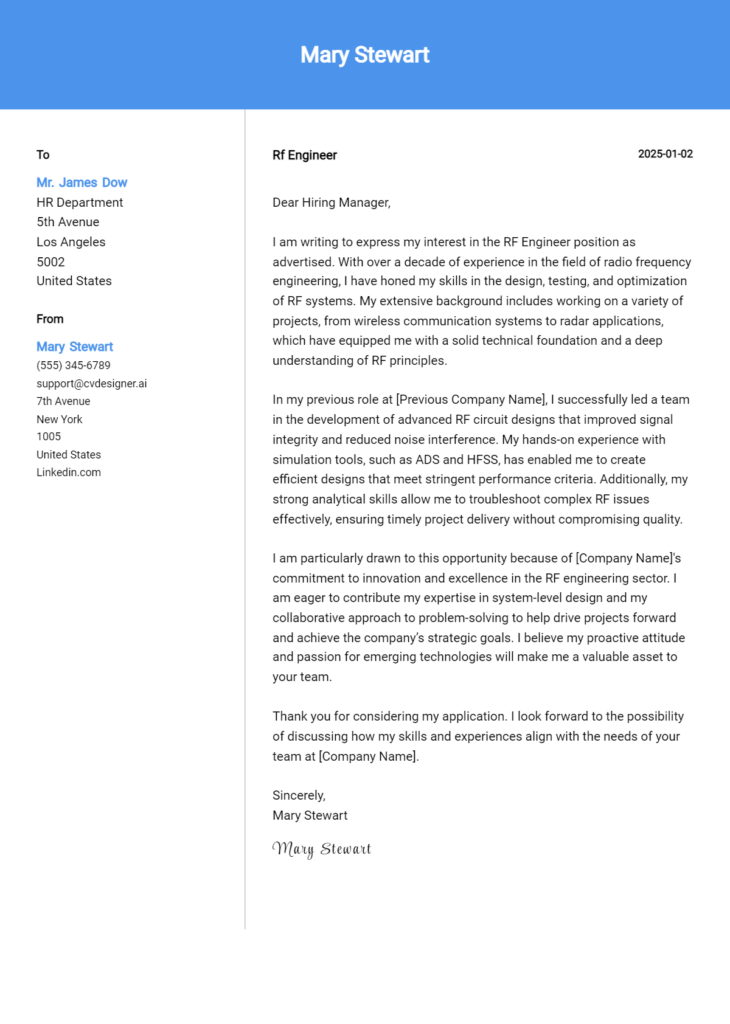Microelectronics Engineer Cover Letter Examples
Explore additional Microelectronics Engineer cover letter samples and guides and see what works for your level of experience or role.
How to Format a Microelectronics Engineer Cover Letter?
Crafting a compelling cover letter is essential for Microelectronics Engineers, as it serves as your first opportunity to communicate your technical expertise and problem-solving abilities to potential employers. The presentation of your skills and experience is paramount; it not only reflects your attention to detail but also demonstrates your understanding of the precision required in microelectronics. A well-structured cover letter can effectively capture the hiring manager's attention and set you apart in a competitive job market.
In this guide, we will outline the key components of a professional cover letter, providing insights and examples specifically tailored for Microelectronics Engineers.
We will focus on the essential elements, including:
- Cover Letter Header
- Cover Letter Greeting
- Cover Letter Introduction
- Cover Letter Body
- Cover Letter Closing
Each section is crucial for showcasing your qualifications and professionalism. Let’s dive into the details of how to create a standout cover letter for your career in microelectronics.
Importance of the Cover Letter Header for a Microelectronics Engineer
The header of a cover letter is a vital component that sets the tone for the entire document. It provides essential information at a glance, ensuring clarity and professionalism from the outset. For a Microelectronics Engineer, where technical precision and attention to detail are paramount, a well-structured header can help create a positive first impression. The header should include your contact information, the date, and the recipient's details, all presented in a clear and organized manner. This not only reflects your communication skills but also your commitment to presenting yourself professionally.
Strong Example
John Doe 1234 Silicon Valley Rd Tech City, CA 90210 johndoe@email.com (123) 456-7890 March 15, 2023 Dr. Jane Smith Hiring Manager Microelectronics Innovations Inc. 5678 Tech Lane Innovation City, CA 90211
Weak Example
johndoe@email.com March 15, 2023 Microelectronics Innovations Inc. 5678 Tech Lane Innovation City, CA 90211
The Importance of the Cover Letter Greeting
The cover letter greeting is a critical element that sets the tone for the entire letter, making it essential for job applicants, particularly for specialized roles like a Microelectronics Engineer. A well-crafted greeting reflects professionalism and demonstrates a personal touch by directly addressing the hiring manager. This initial connection can make a positive first impression, signaling that the applicant values the opportunity and has taken the time to tailor their application. To avoid generic greetings, candidates should strive to research the recipient's name, which can often be found on the company's website or LinkedIn. Doing so not only shows initiative but also enhances the likelihood of engaging the reader.
Here are examples of strong and weak greetings for a Microelectronics Engineer cover letter:
Strong Example
Dear Dr. Smith,
Weak Example
To Whom It May Concern,
The Importance of a Well-Crafted Cover Letter Introduction for a Microelectronics Engineer
A well-crafted cover letter introduction is crucial for a Microelectronics Engineer as it sets the tone for the entire application. This opening paragraph should captivate the hiring manager's attention, clearly express the candidate's enthusiasm for the role, and succinctly highlight relevant skills or achievements that make the candidate a strong fit. A strong introduction not only piques interest but also lays the foundation for the rest of the letter, encouraging the reader to learn more about the candidate's qualifications.
Strong Example
Dear [Hiring Manager's Name], I am excited to apply for the Microelectronics Engineer position at [Company Name], where I can leverage my extensive background in semiconductor design and fabrication to contribute to your innovative projects. With over five years of experience developing high-performance microchips for consumer electronics and a proven track record of reducing production costs by 20%, I am eager to bring my expertise to your talented team and help drive advancements in cutting-edge technology.
Weak Example
To whom it may concern, I am writing to apply for the Microelectronics Engineer job. I have some experience in this field and think it could be a decent opportunity for me. I am interested in working with your company, but I am not sure what specific skills I can bring.
Purpose of the Cover Letter Body for a Microelectronics Engineer
The cover letter body for a Microelectronics Engineer serves as a critical tool for candidates to effectively communicate their technical skills, relevant experiences, and the unique value they can bring to a prospective employer. This section allows applicants to highlight specific projects or accomplishments that demonstrate their expertise in microelectronics design, fabrication, or testing. By articulating these achievements, candidates can create a compelling narrative that showcases their problem-solving abilities and innovative contributions, helping to establish their suitability for the role and alignment with the company’s goals.
Strong Example
Dear Hiring Manager, I am excited to apply for the Microelectronics Engineer position at XYZ Corporation. In my previous role at ABC Technologies, I led a cross-functional team in the development of a novel low-power microprocessor that achieved a 30% reduction in energy consumption compared to existing models. This project not only enhanced our product line but also received the 2022 Innovation Award from the Semiconductor Industry Association. My expertise in CAD tools and experience with advanced semiconductor materials have equipped me with the skills to contribute effectively to your team. I am particularly drawn to XYZ Corporation's commitment to sustainability in microelectronics, and I believe my background aligns well with your mission. Thank you for considering my application. Sincerely, [Your Name]
Weak Example
Dear Hiring Manager, I am interested in the Microelectronics Engineer position. I have a degree in electrical engineering and have worked on various projects. I think I can do well in this role. I once worked on a project that involved designing circuits, and I learned a lot from it. I have some experience with software tools that are used in microelectronics. I hope to bring my skills to your company. Thank you for your time. Best, [Your Name]
Importance of the Cover Letter Closing for a Microelectronics Engineer
The closing paragraph of a cover letter is crucial for leaving a lasting impression on potential employers. For a Microelectronics Engineer, it should effectively summarize your qualifications, reiterate your enthusiasm for the position, and prompt the hiring manager to take the next steps, such as reviewing your resume or scheduling an interview. A strong closing not only reinforces your fit for the role but also conveys your proactive attitude and eagerness to contribute to the company. Conversely, a weak closing might fail to inspire action or leave doubts about your interest and capabilities.
Strong Example
Thank you for considering my application for the Microelectronics Engineer position. With my extensive experience in semiconductor design and a passion for innovative technology, I am excited about the opportunity to contribute to your team at [Company Name]. I believe my skills in circuit design and process optimization will align well with your goals. I look forward to the possibility of discussing how I can help advance your projects. Please feel free to review my resume, and I hope to schedule an interview soon.
Weak Example
I hope you like my application. I think I would be okay for the Microelectronics Engineer job. If you want to talk, you can call me. Thanks for your time.
These tips are designed to assist candidates in crafting an effective cover letter for a Microelectronics Engineer position. A well-written cover letter is crucial for making a strong first impression on potential employers. It’s important to highlight not only your technical skills and problem-solving abilities but also your knowledge of the Software Development Life Cycle (SDLC), your experience in teamwork, and your passion for continuous learning. By effectively communicating these qualities, you'll demonstrate your fit for the role and your potential contributions to the team.
Cover Letter Writing Tips for Microelectronics Engineer
Showcase Your Technical Skills
Clearly outline your technical abilities relevant to microelectronics engineering, such as circuit design, semiconductor physics, and signal processing. Use specific examples from your past work or projects to illustrate how you’ve applied these skills in real-world scenarios. Consider integrating relevant keywords to align with the job description, which can also enhance your visibility in applicant tracking systems.Emphasize Problem-Solving Abilities
Microelectronics engineering often involves tackling complex challenges. Highlight instances where you’ve successfully solved technical problems, whether through innovative designs or efficient troubleshooting. Describe your analytical approach and how your solutions contributed to project success, showcasing your capability to think critically under pressure.Demonstrate Knowledge of the Software Development Life Cycle (SDLC)
If applicable, discuss your familiarity with the SDLC and how it relates to microelectronics projects. Explain your role in the development process, whether in planning, execution, or testing. Illustrating your understanding of SDLC will position you as a well-rounded candidate who can navigate both hardware and software aspects of microelectronics engineering.Highlight Teamwork and Collaboration
Microelectronics projects often require collaboration with cross-functional teams. Share examples of how you’ve effectively worked within a team, emphasizing communication, conflict resolution, and your ability to contribute to a collective goal. This will illustrate your interpersonal skills and ability to thrive in a collaborative environment.Express Your Passion for Continuous Learning
The field of microelectronics is constantly evolving. Convey your enthusiasm for staying updated with the latest technologies and industry trends. Mention any courses, certifications, or workshops you’ve undertaken, and how they have enriched your expertise. This demonstrates your commitment to professional growth and adaptability, making you an attractive candidate for potential employers.
For additional resources, consider exploring cover letter templates or using a cover letter builder to streamline the creation of your application materials. These tools can help you format your letter professionally and ensure you include all the necessary elements.
Common Mistakes to Avoid in a Microelectronics Engineer Cover Letter
Crafting a compelling cover letter is essential for microelectronics engineers seeking to make a strong first impression on potential employers. Avoiding common pitfalls can significantly enhance your chances of landing an interview. Here are some frequent mistakes to watch out for:
- Generic Content: Using a one-size-fits-all approach can backfire. Tailor your letter to the specific job and company by highlighting relevant skills and experiences.
- Neglecting Formatting: A poorly formatted cover letter can distract from your message. Refer to our cover letter format guide for tips on presenting your information clearly.
- Lack of Specific Examples: Failing to provide concrete examples of your achievements can weaken your case. Use specific projects or accomplishments to demonstrate your expertise in microelectronics.
- Ignoring Keywords: Many companies use automated systems to screen applications. Incorporate relevant keywords from the job posting to ensure your cover letter passes these initial filters.
- Excessive Length: A lengthy cover letter can lose the reader's interest. Aim for a concise and focused letter, ideally no longer than one page.
- Spelling and Grammar Errors: Typos can undermine your professionalism. Always proofread your letter or use tools to check for errors before submission.
- Failing to Show Enthusiasm: Employers want to see your passion for the role. Convey your interest in the position and the company to leave a positive impression.
By steering clear of these mistakes and following effective cover letter examples, you can create a strong and persuasive cover letter that sets you apart from the competition.
Cover Letter FAQs for Microelectronics Engineer
What should I include in my cover letter as a Microelectronics Engineer?
In your cover letter, it’s important to highlight your technical skills and relevant experience. Start with a strong introduction that states the position you're applying for and express your enthusiasm for the role. Include specific projects or experiences that demonstrate your expertise in microelectronics, such as designing integrated circuits or working with semiconductor fabrication. Mention any relevant certifications, software tools you’re proficient with, and your ability to work in cross-functional teams. Finally, convey your passion for innovation and how you can contribute to the company's goals.
How can I tailor my cover letter for a specific job application?
To tailor your cover letter, carefully read the job description and identify keywords and skills that the employer emphasizes. For instance, if the position focuses on RF design or VLSI technology, incorporate those terms and relate them to your experiences. Use specific examples from your past work that align with the company’s projects or values. Show that you understand the company's mission by researching its recent developments or technologies they’re working on. This personalized approach demonstrates your genuine interest in the role and helps you stand out.
Should I include technical jargon in my cover letter?
Including technical jargon can be beneficial if used appropriately. It shows your familiarity with the field and indicates that you have the knowledge required for the position. However, ensure that the jargon is relevant and can be understood by the hiring manager, who may not be a technical expert. Strike a balance by explaining complex concepts in simpler terms or providing context around terms that are crucial to your qualifications. This approach keeps your cover letter professional while still showcasing your technical expertise.
How long should my cover letter be?
Your cover letter should ideally be one page long, typically consisting of three to four paragraphs. Aim for a concise format that allows you to communicate your qualifications without overwhelming the reader. Each paragraph should serve a specific purpose: an introduction that captures attention, a body that highlights your relevant experiences, and a closing that expresses your enthusiasm and readiness for an interview. Keeping it to one page ensures that hiring managers can quickly digest your qualifications while maintaining interest in your application.
Build your Cover Letter in minutes
Use an AI-powered cover letter builder and have your letter done in 5 minutes. Just select your template and our software will guide you through the process.

